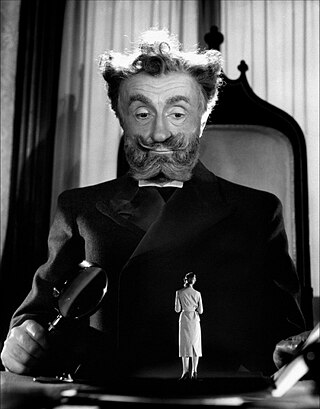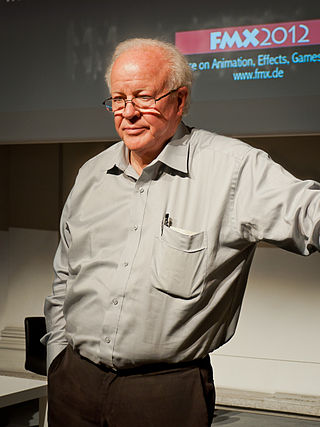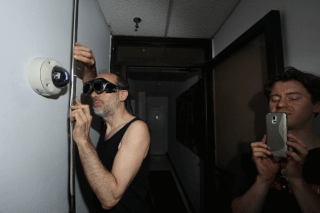
Special effects are illusions or visual tricks used in the theatre, film, television, video game, amusement park and simulator industries to simulate the imagined events in a story or virtual world. It is sometimes abbreviated as SFX, but this may also refer to sound effects.

Morphing is a special effect in motion pictures and animations that changes one image or shape into another through a seamless transition. Traditionally such a depiction would be achieved through dissolving techniques on film. Since the early 1990s, this has been replaced by computer software to create more realistic transitions. A similar method is applied to audio recordings, for example, by changing voices or vocal lines.

Motion blur is the apparent streaking of moving objects in a photograph or a sequence of frames, such as a film or animation. It results when the image being recorded changes during the recording of a single exposure, due to rapid movement or long exposure.

Cinematography is the art of motion picture photography.
Bullet time is a visual effect or visual impression of detaching the time and space of a camera from that of its visible subject. It is a depth enhanced simulation of variable-speed action and performance found in films, broadcast advertisements, and realtime graphics within video games and other special media. It is characterized by its extreme transformation of both time, and of space. This is almost impossible with conventional slow motion, as the physical camera would have to move implausibly fast; the concept implies that only a "virtual camera", often illustrated within the confines of a computer-generated environment such as a virtual world or virtual reality, would be capable of "filming" bullet-time types of moments. Technical and historical variations of this effect have been referred to as time slicing, view morphing, temps mort and virtual cinematography.

An in-camera effect is any special effect in a video or movie that is created solely by using techniques in and on the camera and/or its parts. The in-camera effect is defined by the fact that the effect exists on the original camera negative or video recording before it is sent to a lab or modified. Effects that modify the original negative at the lab, such as skip bleach or flashing, are not included. Some examples of in-camera effects include the following:
Panoramic photography is a technique of photography, using specialized equipment or software, that captures images with horizontally elongated fields of view. It is sometimes known as wide format photography. The term has also been applied to a photograph that is cropped to a relatively wide aspect ratio, like the familiar letterbox format in wide-screen video.

Traditional animation is an animation technique in which each frame is drawn by hand. The technique was the dominant form of animation of the 20th century, until there was a shift to computer animation in the industry, such as digital ink and paint and 3D computer animation.

In photography and cinematography, a multiple exposure is the superimposition of two or more exposures to create a single image, and double exposure has a corresponding meaning in respect of two images. The exposure values may or may not be identical to each other.

Douglas Hunt Trumbull was an American film director and visual effects supervisor, who pioneered innovative methods in special effects. He created scenes for 2001: A Space Odyssey, Close Encounters of the Third Kind, Star Trek: The Motion Picture, Blade Runner and The Tree of Life, and directed the movies Silent Running and Brainstorm.

Time-lapse photography is a technique in which the frequency at which film frames are captured is much lower than the frequency used to view the sequence. When played at normal speed, time appears to be moving faster and thus lapsing. For example, an image of a scene may be captured at 1 frame per second but then played back at 30 frames per second; the result is an apparent 30 times speed increase.

Mattes are used in photography and special effects filmmaking to combine two or more image elements into a single, final image. Usually, mattes are used to combine a foreground image with a background image. In this case, the matte is the background painting. In film and stage, mattes can be physically huge sections of painted canvas, portraying large scenic expanses of landscapes.
A front projection effect is an in-camera visual effects process in film production for combining foreground performance with pre-filmed background footage. In contrast to rear projection, which projects footage onto a screen from behind the performers, front projection projects the pre-filmed material over the performers and onto a highly reflective background surface.

Virtual cinematography is the set of cinematographic techniques performed in a computer graphics environment. It includes a wide variety of subjects like photographing real objects, often with stereo or multi-camera setup, for the purpose of recreating them as three-dimensional objects and algorithms for the automated creation of real and simulated camera angles. Virtual cinematography can be used to shoot scenes from otherwise impossible camera angles, create the photography of animated films, and manipulate the appearance of computer-generated effects.

High-speed photography is the science of taking pictures of very fast phenomena. In 1948, the Society of Motion Picture and Television Engineers (SMPTE) defined high-speed photography as any set of photographs captured by a camera capable of 69 frames per second or greater, and of at least three consecutive frames. High-speed photography can be considered to be the opposite of time-lapse photography.

Color motion picture film refers both to unexposed color photographic film in a format suitable for use in a motion picture camera, and to finished motion picture film, ready for use in a projector, which bears images in color.
The following outline is provided as an overview of and topical guide to photography:
Showscan is a cinematic process developed by Douglas Trumbull that uses 70mm film photographed and projected at 60 frames per second, 2.5 times the standard speed of movie film.

Light writing is an emerging form of stop motion animation wherein still images captured using the technique known as light painting or light drawing are put in sequence thereby creating the optical illusion of movement for the viewer.

Strip photography, or slit photography, is a photographic technique of capturing a two-dimensional image as a sequence of one-dimensional images over time, in contrast to a normal photo which is a single two-dimensional image at one point in time. A moving scene is recorded, over a period of time, using a camera that observes a narrow strip rather than the full field. If the subject is moving through this observed strip at constant speed, they will appear in the finished photo as a visible object. Stationary objects, like the background, will be the same the whole way across the photo and appear as stripes along the time axis; see examples on this page.
















